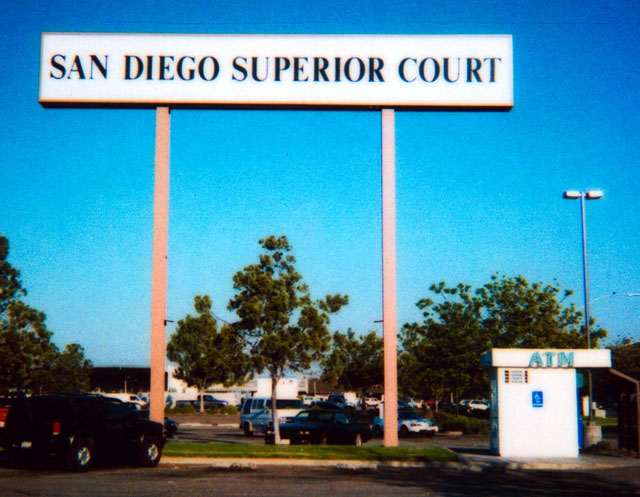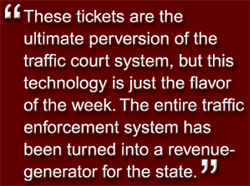San Diego Union-Tribune
Jenifer Hanrahan
STAFF WRITER
Stefanie Steinberg thought her driver’s license photo was bad until she got nabbed by an automated camera while cruising through a yellow light at Garnet Avenue and Ingraham Street in Pacific Beach.
OK, OK. So it was red — by 0.7 of a second.
The slightly blurry, black-and-white photograph came in the mail. It shows her wide-eyed and open-mouthed, gripping the steering wheel with both hands and looking as startled as Leonardo DiCaprio spotted by paparazzi with his pants down.
“I was blinded by the flashes,” said Steinberg, 24, outside of traffic court in Kearny Mesa. “I was scared to death. I didn’t know what was happening.”
Steinberg is one of nearly 4,000 San Diego motorists caught on film each month and ticketed for running red lights. In California, the fine is $346 — the steepest in the nation.
Last year, red-light runners busted by cameras generated $827,000 in city revenue, while violators caught by cops earned only $62,000. Cameras at intersections accounted for about one-fourth of the $3.2 million the city collected for traffic violations.
But as the cameras’ flash catches the eye of more motorists, the high-tech devices are raising concerns of privacy vs. public safety and technological efficiency vs. human judgment.
Supporters of red-light cameras — and surveys show this includes nearly 80 percent of the public — say the devices reduce smash-ups caused by red-light running, one of the most hazardous urban traffic infractions.
“The number of violations at the intersections is going down, and that’s because people are preparing to stop as opposed to preparing to speed up when the light turns yellow,” said Sgt. Terry McManus, a spokesman for San Diego’s red light enforcement program. But detractors say the cameras remind them of Big Brother. They question the revenue-sharing arrangement in which Lockheed Martin IMS, the San Diego-based company that monitors the devices and mails the tickets, receives $70 for every ticket paid in the city of San Diego.
They also claim the cameras target law-abiding, honest motorists because vehicles without front license plates cannot be cited.
“The whole automated enforcement is a bit creepy, and very Orwellian,” said Patrick Mulroy, a traffic school owner and creator of https://www.ticketassassin.com, a Web site that gives information on contesting traffic tickets. “And once people understand the system, anybody that wants to avoid this ticket can take their front license plate off. From a fairness perspective, automated enforcement is a sham.”
Watching over you
The driver may have been in a hurry, or maybe distracted by a cell phone. Either way, around Christmastime four years ago, a motorist drove through the intersection of Fletcher Parkway and Magnolia Avenue in El Cajon about a second after the light turned red.
Click! Click!
As the car passed over two sensors embedded in the road, a camera flashed twice, and the unlucky driver became the first person ticketed by a red-light camera in the San Diego area.
Red-light cameras have been common in Europe since the late ’80s, but the concept has only recently caught on in the United States.
San Diego installed its first red-light camera less than two years ago.
Now, with 16 cameras in place and plans for another 16 this year, San Diego’s program is one of the most extensive.
El Cajon, the only other local municipality with red-light cameras, has two that rotate among six intersections. Nearly 40 jurisdictions nationwide — including 16 in California — have red-light cameras and a dozen others are considering it, said Richard Retting, senior transportation engineer at the Insurance Institute for Highway Safety.
But California’s penalties for red light tickets are the harshest.
In most states, red light tickets are treated like parking tickets. Cameras photograph the rear license plate only, and the registered owner of the vehicle has to pay the ticket, regardless of who was driving. The fines range from about $50 to $75 and do not result in points on the driving record.
In 1998, the California’s Legislature nearly tripled the fine for running a red light from $103 to $346. Tickets also result in points — and potentially higher insurance rates. San Diego Superior Court tacks on a $30 fee for anyone opting to go to traffic school, which costs an additional $15 or so.
One reason for higher fines in California is because state law requires identification of the driver before a ticket is issued, meaning cities can’t rely on a high volume of tickets to pay for the program, Mulroy said.
But police officers and state legislators who voted for the higher fines say the stiff penalties deter red-light running and fit the seriousness of the infraction.
From 1992 to 1996, an estimated 260,000 crashes nationwide resulted from red-light running, according to an Insurance Institute for Highway Safety study. About 750 people die each year; 154 of them in California, making this state’s intersections the deadliest.
At busy intersections, studies have shown red lights are run as often as every 10 minutes. “This creates a Russian roulette for the driver,” Retting said. “In many cases, running a red light will not have a consequence to it. But when it does, it can be a catastrophe.”
But some studies show the deterrent effect is unrelated to higher fines. An institute study of Oxnard and Fairfax, Va., found both cities saw an average 40 percent drop in violations a year after red-light cameras were installed, Retting said.
In Fairfax, the fine is $50.
Enforcement issues
In some respects, the cameras are brutally efficient. Unlike a cop, they don’t waste time listening to lame excuses. There’s no chance they’ll give you a stern warning and let you slide.
And yet, most violators nailed by the cameras are never ticketed.
Glare, a blurry photo and missing front license plates mean police don’t cite from 60 to 70 percent of red-light runners.
For rental cars, company cars or in cases in which the registered owners prove someone else was driving their cars, police typically rely on the cooperation of the business or vehicle owner to identify the driver.
For instance, airport traffic making a left from North Harbor Drive onto Grape Street does the most red-light running in San Diego. In February, cameras recorded 2,652 violations, but only 985 citations were issued.
Even if lots of drivers are getting away with it, police are issuing far more tickets than before, McManus said. The corner of Harbor and Grape was rarely staked out by motor officers because there was no safe or effective vantage point to watch or enter traffic.
Drivers considering taking off the front plate to avoid a red light ticket, be warned: The equipment violation, a “fix-it” ticket with a $10 fee after you prove you’ve put the plate back on the car, gives police probable cause to pull you over at any time.
And San Diego police are pulling over more drivers than ever for missing front plates.
“That means if you’ve had two drinks and you’re driving, you could turn something relatively minor into a very serious offense,” Mulroy said.
Some drivers are willing to take their chances. One Solana Beach man, who asked to not be identified, knew his picture was taken driving through an intersection. He didn’t worry because he doesn’t have a front plate.
“There’s no way I’m putting it on,” he said.
Decreasing violations
It’s too early to determine if San Diego’s program has reduced traffic accidents.
What’s sure is that the number of violations is decreasing as drivers become aware of the cameras. At the corner of Palm Avenue and Beyer Boulevard, violations decreased so much the camera is not being monitored, said San Diego Police Officer Scott A. Thompson.
That situation illustrates the Catch-22 of making red-light enforcement profitable in the long term. When fewer people run red lights, fewer tickets are generated, making it harder to pay for the expensive equipment and technicians needed to operate the program.
In the city of San Diego, Lockheed Martin IMS provides the cameras, each worth about $50,000, installation, servicing, initial film review and mailing of citations.
In return, Lockheed Martin gets $70, or a little less than half, of the $143.86 state law says the city of San Diego can net per ticket.
“That’s one of the beauties of the program,” said Dana King, vice president of marketing for Lockheed Martin IMS. “The violators are paying for the program. (The city) gets a traffic safety program and they don’t have to incur the costs.”
That may work in a city with lots of traffic, but smaller cities are having a harder time. It will take three years for El Cajon, which put up money for some of the equipment, to break even, said Ed Krulikowski, city traffic engineer.
Poway recently halted its red-light camera enforcement when contract negotiations faltered with Lockheed after the company said it wanted to start charging a monthly fee. “We calculated that we would lose money on it,” said Mike Robinson, Poway’s traffic engineer.
While Lockheed says it has yet to turn a profit on the cameras in San Diego, some drivers are skeptical of profit-seeking companies handing out tickets. “We’re going on their word that these cameras are accurate,” said Brent Hodge, fighting his ticket in traffic court. “The company that makes them is the company that maintains them. They’re not out for traffic safety. They’re out for a buck. And I’m supposed to trust them?”
While there is no independent calibration or verification that the cameras are accurate, King says the system is designed to ensure photographs are taken only when the light is red.
Before the cameras are put into place, city engineers make sure the lights are timed correctly, giving motorists adequate time to stop, given the speed limit of the road.
“If you believe in black helicopters coming down in the middle of the night then you’re going to think anything is suspect,” King said. “There is an integrity to the contract with the city and to the court of law.”
Day in court
On a recent evening at San Diego Superior Court, nine men and women clutched citations containing seemingly damming photographic evidence.
Two nights a week have been set aside for camera violations.
About 8 percent of drivers ticketed by red-light cameras go to court over the citation, making up about 20 percent of trials at the Kearny Mesa branch of the San Diego County Superior Court, said Stephen Thunberg, executive officer of the courthouse.
Leroy Brady, 29, was in the car with his wife and 8-year-old daughter when he got nailed. Brady stood before the judge and said the light was yellow. He said he would never do anything to put his family in jeopardy. He said he could not have stopped safely.
He even called a witness — his wife, Melanie Roiz.
“At any point, did you perceive danger?” Brady asked her.
“No,” she replied.
“As we were driving through the light did you think anybody was going to hit us or I was going too fast?”
“No.”
“Did you at anytime think we were going to run the light?”
“No.”
Wielding diagrams and a felt-tip marker, Officer Scott Thompson, trained by Lockheed to interpret the data, did a series of math equations to prove Brady could have safely stopped.
In the end, the judge offered Brady a deal — either have his fine reduced, or pay the fine and go to traffic court to avoid a point on his license.
“I drove safely. I had everybody’s well-being in mind,” Brady said. “You can do all that figuring, but unless you’re in the car you can’t know.”
Several people got out of paying. Brent Hodge’s ticket was dismissed because his car was in lane No. 1 in the photograph, but the information on the ticket said he was in lane No. 2.
Nick Dalfio, a driver for a bread company, was waiting for the light to change at about 3 a.m. Without another car in site, he said made a U-turn while the light was still red. His case was dismissed because his car did not cross the sensor about 10 feet into the intersection.
“I wasn’t going to pay all that money without a fight,” Dalfio said.
Stefanie Steinberg’s ticket was dismissed when the court did not have the correct paperwork. She walked out of the courtroom, wide-eyed and open-mouthed at her good fortune.


